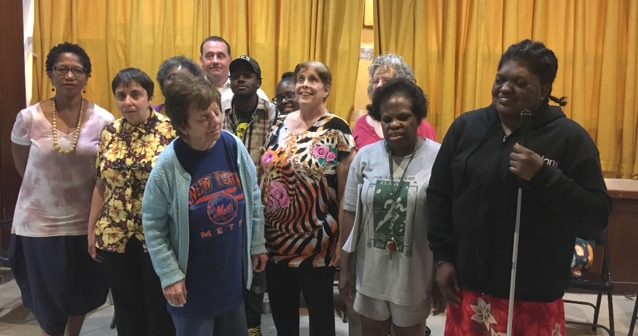In spring 2017, T&W teaching artists Dave Johnson, Jessie Paddock, and Samantha Thomson LoCoco led a playwriting program for older adults at VISIONS: Services for the Blind and Visually Impaired. The outline below is an overview of the six writing lessons that preceded participants’ rehearsals and final performance. T&W thanks Aroha Philanthropies for its generous support of our programs at VISIONS.
Level: Adults
Genre: Songwriting
Download: Playwriting at VISIONS
LESSON 1: Feedback Structure, Storytelling from Personal Experience, and Monologue
The teaching artists introduce brief excerpts from Fences (August Wilson), A Raisin in the Sun (Lorraine Hansberry), and 27 Wagons Full of Cotton (Tennessee Williams) as mentor texts and establish a formal feedback method based on Liz Lerman’s Critical Response Process (CRP). After presenting each excerpt, the teaching artists invite participants to reflect on dramatic structure and to use CRP to consider and discuss characters’ motivations for revealing information at a particular moment in the play. Participants share stories about personal experiences and write monologues based on those experiences.
LESSON 2: Character Development
This lesson explores behavior, observation techniques, and the invention of psychological history as a way to imagine and develop characters. This session uses the “Character Bone Structure” from Lajos Egri’s The Art of Dramatic Writing as an aid to discussing components of character, including the importance of a character’s actions, internal/external life, motivations and objectives, and how to build a fictional being from the ground up. Teaching artists provide specific writing exercises to underline the discussion (e.g., interviewing characters). Participants apply this lesson to their previous work or start something new.
LESSON 3: Dialogue
Teaching artists introduce and read dialogue from Fences (August Wilson). Group discusses how playwrights make bold choices, develop dramatic conflict, and keep the stakes high for their characters. This lesson employs “neutral scenes” as a way to explore the relationships between characters and the use of multiple voices. Teaching artists invite participants to work in pairs to create the who, what, when, and where of a neutral scene. Together they answer questions such as: What is my character’s objective? What do I want the other character to do? What is my character’s internal/external obstacle? Participants continue to develop their pieces from the previous week and begin to introduce dialogue into their texts.
LESSON 4: Multi-Character Scenes
Teaching artists read aloud short excerpts from 27 Wagons Full of Cotton (Tennessee Williams) to serve as mentor texts and offer points for discussion. How does the playwright juggle several characters onstage at once? What strategies can a writer employ to make this task more manageable? With a focus on generating multi-character scenes, participants build upon work from previous weeks or begin something new.
LESSON 5: Plot, Stakes, and Theme
Building on previous sessions, participants focus on what follows establishing the character and the associated through line. How is plot outlined and the stakes upped to create maximum tension/drama? How can a theme be supported in every moment of a play? How can premise continue to be incorporated into the story arc? In what ways can premise inform dialogue, action, and character development? Participants continue to work on their pieces and select the one they want to perform at the final event.
LESSON 6: Revision and Stage Directions
A play, of course, is a piece of writing that is meant to be performed. What sensory details must the playwright consider when drafting a scene that is meant to take place in a live space? While the director and actors ultimately execute the words on the page, the playwright still must consider the physical space, setting, entrances/exits, etc. when drafting their story. The group discusses writing for different types of production (e.g., radio/podcast vs. stage). Teaching artists provide examples of writing for the ear and how that functions in various types of production. Participants revise the pieces they selected for performance.




